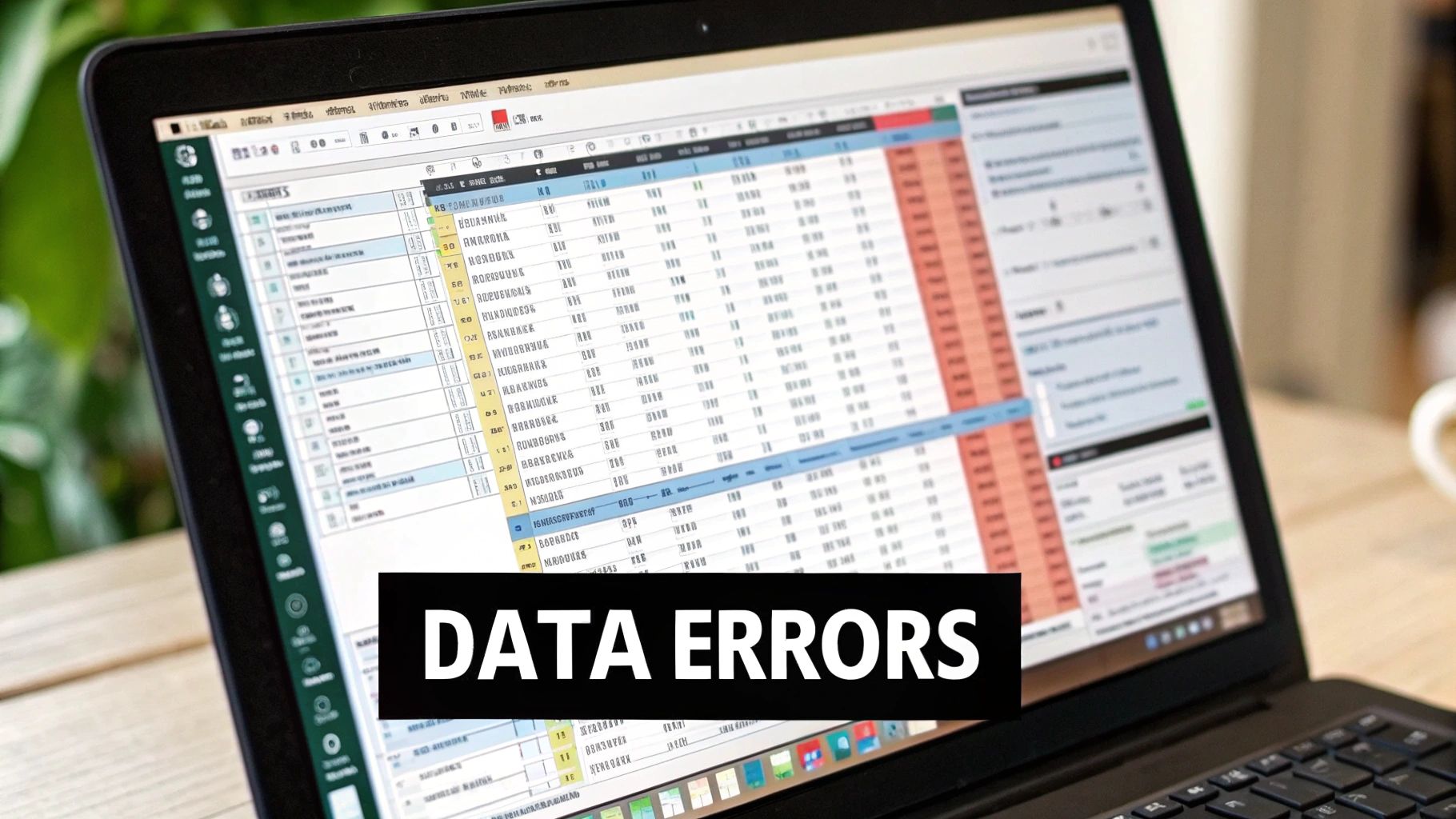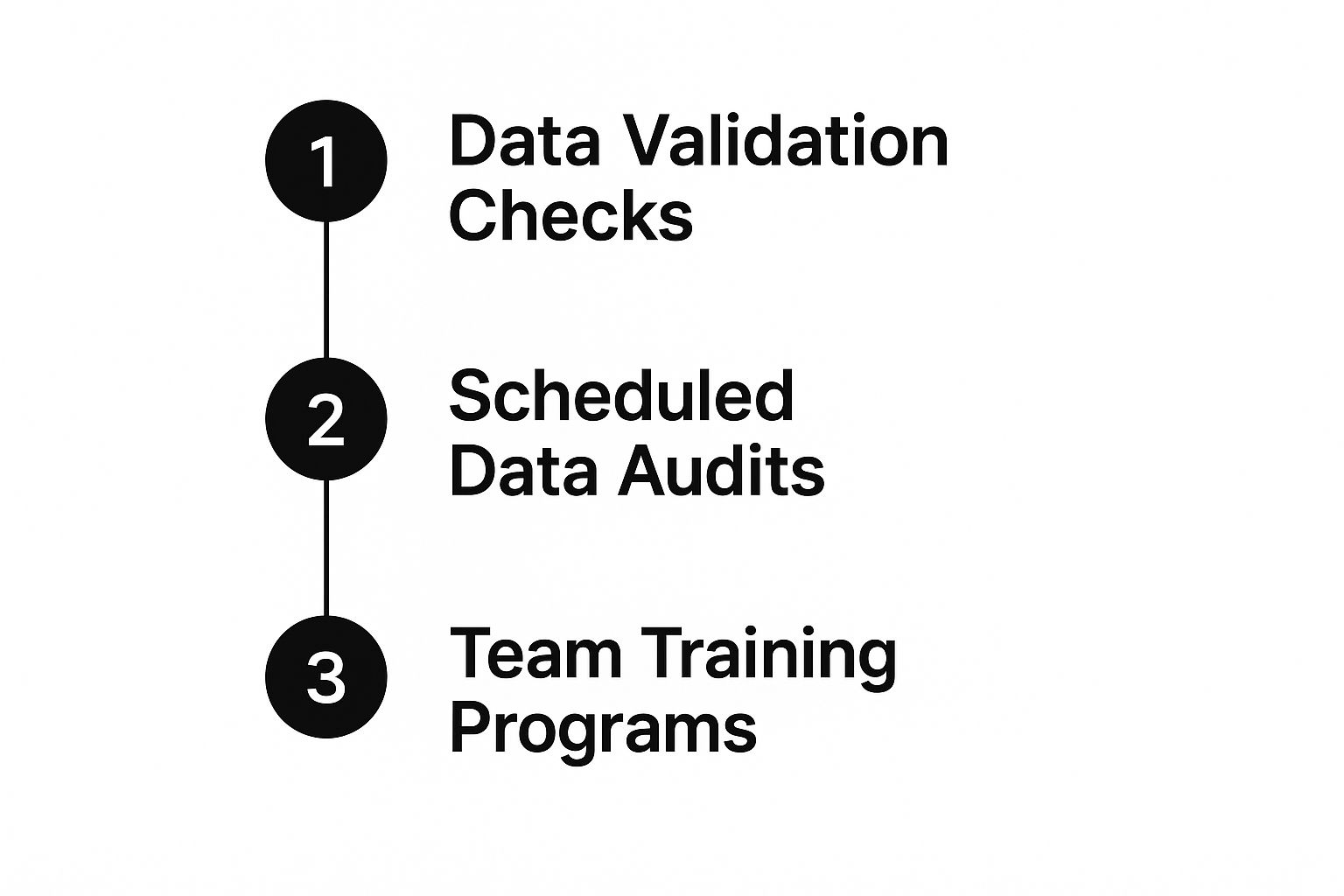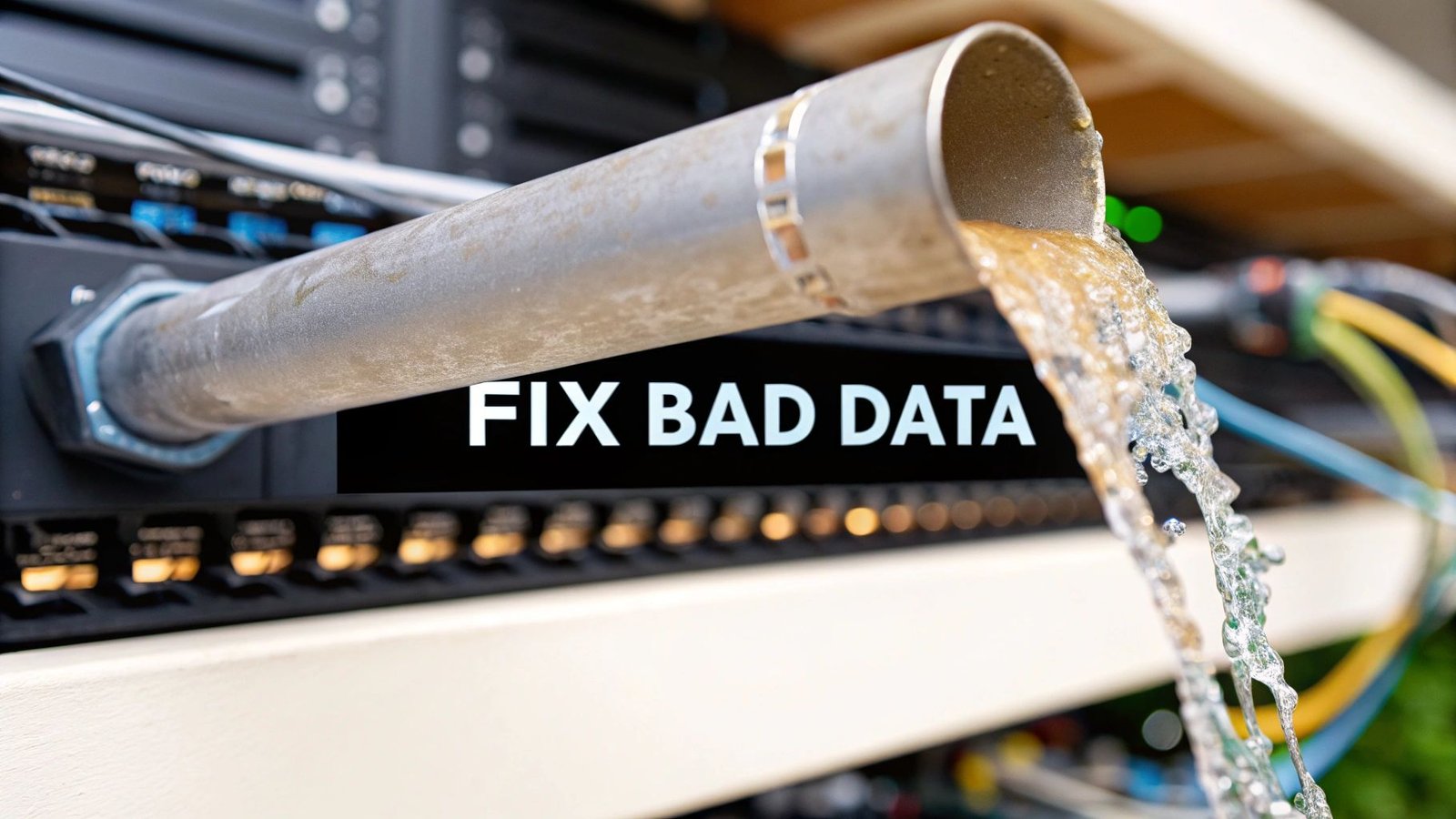Data quality problems are the errors, inconsistencies, and plain old inaccuracies lurking in your datasets. Think of them as cracks in the foundation of your business intelligence. Small flaws like duplicate entries, missing phone numbers, or outdated addresses might seem minor, but they can lead to major strategic failures and real financial losses.
Why Bad Data Is a Silent Business Killer
Ever seen someone try to build a skyscraper on a foundation of sand? That’s what it's like to run a business on poor-quality data. It might feel like a background IT issue, but the reality is that data quality problems are a silent but powerful threat to your company's health and bottom line. Every flawed decision, wasted marketing dollar, and missed opportunity can almost always be traced back to that shaky foundation of unreliable information.
This isn't just a hypothetical problem; the financial consequences are very real. The economic hit is staggering, with some organizations losing an average of 25% of their revenue each year simply due to data-related mistakes. What's more, companies struggling with poor data quality see a 60% higher project failure rate than those who invest in keeping their data clean. You can find more insights on these data transformation challenges over at Integrate.io.
The Ripple Effect of a Single Bad Entry
A single incorrect data point rarely stays in its own lane. It creates a ripple effect, spreading across departments and contaminating everything it touches.
- Marketing Campaigns Fall Flat: When customer data is wrong, your personalized emails land in spam folders, your direct mail gets returned, and your ad budget is blown on audiences who will never buy from you.
- Sales Efforts Go Nowhere: Imagine your sales team working with incomplete or duplicate lead info. They end up wasting precious time chasing dead ends or, even worse, calling the same prospect multiple times, which can sour a relationship before it even starts. Clean data is crucial, and you can learn more about how it fuels an effective sales automation process in our detailed guide.
- Strategic Decisions Turn into Guesses: Leadership depends on analytics to guide the ship. But if those analytics are built on faulty data, the reports are dangerously misleading. Confident strategic planning quickly becomes a high-stakes gamble.
Eroding Trust and Killing Growth
Perhaps the most insidious damage from persistent data quality issues is the erosion of trust. When your team can't rely on the information in their CRM or databases, they simply stop using them. They fall back on manual workarounds, gut-feel decisions, and siloed spreadsheets, which completely defeats the purpose of having a centralized data strategy in the first place.
Poor data quality doesn't just create operational friction; it fosters a culture of doubt. When your team stops trusting the data, they stop trusting the decisions based on it. This leads to hesitation, internal conflict, and a critical loss of competitive momentum.
This collapse in confidence directly torpedoes your ability to innovate. Ambitious projects involving AI and machine learning are doomed from the start if the data they're trained on is junk. It’s the classic "garbage in, garbage out" scenario. Before you can build a truly data-driven future, you have to make sure your foundation is solid, reliable, and clean.
Diagnosing Your Data Quality Problems

Before you can fix your data, you need to know exactly what’s broken. It's a lot like a doctor diagnosing an illness—you can't just start prescribing medicine without understanding the symptoms. Jumping straight to solutions without a clear diagnosis is a recipe for wasted time, money, and effort.
The first step is to get specific. Instead of just saying "our data is a mess," you need to pinpoint the exact types of data quality problems plaguing your systems. These issues show up in a few distinct ways, and each one creates its own unique brand of chaos for your business.
Let's break them down.
Pinpointing Inaccurate and Incomplete Data
The most obvious data quality issue is simply inaccurate data. This is information that is just plain wrong. It could be a customer’s name spelled incorrectly, a product price with a typo, or a ZIP code that doesn't exist. These might feel like small slip-ups, but they add up fast. In fact, Gartner estimates that bad data costs companies an average of $12.9 million a year.
A close cousin to inaccurate data is incomplete data. This is when you have records with crucial information missing. Think of a customer profile without an email or a lead record without a phone number. These gaps create dead ends, making it impossible for your teams to follow up, personalize campaigns, or close a deal.
A good first line of defense is making key fields mandatory at the point of entry. It's a simple validation step that ensures every new record meets a minimum standard of usability.
The real danger of inaccurate and incomplete data is that it silently sabotages your operations. A single wrong digit in a financial report can mislead an entire executive team, while a missing address field can halt a critical shipment indefinitely.
Tackling Duplicate and Inconsistent Entries
Another headache that pops up everywhere is duplicate data. This happens when the same person, product, or company gets entered into your system more than once. It’s a common side effect of merging different lists, like importing contacts from a trade show into your existing CRM.
Duplicates create chaos. They splinter a customer’s history across multiple records, making a 360-degree view impossible. This leads to embarrassing and costly mistakes, like a salesperson cold-calling a prospect who is already a loyal, long-term customer.
Then you have the problem of inconsistent formatting, where the same piece of information is recorded in different ways. Just think about all the ways a single date can be written:
- June 5, 2023
- 6/5/2023
- 05-JUN-23
- The fifth of June, 2023
Without a standard format, trying to sort, filter, or analyze your data becomes a nightmare. This isn’t just a minor annoyance, either. A famous mix-up over formatting led to NASA losing its $125 million Mars Climate Orbiter because one engineering team used the metric system while another used English units.
Identifying Stale and Unstructured Data
Finally, there’s stale data—information that was correct once but is now out of date. People move, change jobs, and get new phone numbers all the time. A customer database that hasn’t been touched in a few years is probably full of invalid addresses, rendering it almost useless for a direct mail campaign.
That's why regularly purging or updating old records is so important. Often, it's far cheaper to delete data past a certain age than to deal with the fallout of using it.
On the other end of the spectrum is unstructured data. This is all the valuable information that doesn't fit into neat rows and columns—things like notes from a sales call, customer feedback in a survey, or comments on social media. According to IBM, as much as 80% of all data today is dark or unstructured, which represents a massive, untapped source of insight.
Common Data Quality Issues and Their Business Impact
To pull this all together, here's a quick look at these common data problems, what they look like, and the real-world consequences they create.
| Data Quality Problem | Description | Example Business Impact |
|---|---|---|
| Inaccurate Data | Information that is factually incorrect or contains errors. | Sending a shipment to the wrong address, leading to lost inventory and customer dissatisfaction. |
| Incomplete Data | Records with missing values in important fields. | Being unable to contact a high-potential sales lead because their phone number is missing. |
| Duplicate Data | The same entity is listed multiple times in a database. | A support team sees only part of a customer's history, providing poor and fragmented service. |
| Inconsistent Formatting | The same data is represented in different formats across records. | Inability to generate accurate quarterly reports because revenue dates are formatted differently. |
| Stale Data | Information that was once accurate but is now outdated. | Wasting marketing budget on a direct mail campaign sent to thousands of old, invalid addresses. |
By recognizing these specific symptoms in your own systems, you can move beyond guesswork and start creating a targeted plan to fix what's actually broken.
Finding the Root Causes of Flawed Data

Trying to fix data errors one by one is a losing battle. It’s like mopping up a puddle on the floor without ever fixing the leaky pipe overhead. You’re just treating the symptom, not the source, and it’s an exhausting, never-ending cycle.
To really get a handle on your data quality problems, you have to shift your mindset from correction to prevention. That means putting on your detective hat. Your mission is to trace every bad data point back to where it came from. Was it a simple typo? A confusing form field? Or is there something deeper and more systemic going on?
This investigation, known as root cause analysis, is where the real work happens. It’s how you find the leverage you need to build a reliable data foundation for the long haul. And almost every time, these root causes fall into one of three buckets: people, processes, or technology. Figuring out which of these is your leaky pipe is the first step toward a permanent fix.
Human Error and Training Gaps
More often than not, the most common source of bad data is also the simplest: human error. We’ve all been there. A tired employee misspells a name, enters a phone number in the wrong field, or just forgets to fill out a required section.
While a single mistake is no big deal, consistent patterns of these errors point to a much bigger problem. Usually, it's a breakdown in training or a lack of clear, consistent rules. If your team doesn't have a standardized way to enter something as simple as a date or a country name, everyone just makes up their own version.
- Inadequate Onboarding: When new hires aren’t shown the right way to enter data from day one, they quickly develop bad habits that are a pain to correct later.
- Lack of Clear Standards: Without a shared data dictionary or style guide, one person’s “USA” is another’s “United States.” This creates a mess of duplicate records that makes any real analysis impossible.
- Pressure to Work Quickly: When the clock is ticking and speed is the only thing that matters, people cut corners. That inevitably leads to incomplete or just plain wrong data.
Broken Processes and Data Silos
Even if you have the best-trained team in the world, your internal processes can still be a massive source of data quality headaches. When departments work in their own little worlds, they create data silos.
The marketing team has their version of a customer, the sales team has another, and the support team has a third. None of them are complete, and they probably contradict each other. This kind of fragmentation is a recipe for disaster. When you try to merge data from these different systems, you’re guaranteed to end up with duplicates and conflicting information.
The real danger of data silos isn't just duplicate data; it's the creation of multiple 'truths' within the business. When teams operate with conflicting information, collaboration breaks down, and strategic alignment becomes impossible.
To fix this, you have to map out your data’s entire journey from start to finish. Pinpoint every spot where data is created, edited, or passed along. This process will shine a bright light on the bottlenecks and weak points where quality is most likely to suffer.
Technology and System Limitations
Finally, your technology stack itself can be the culprit. Outdated software, systems that aren't integrated properly, and a lack of automation can all contribute to the problem. An old CRM, for example, might not have the validation rules needed to stop someone from entering letters into a ZIP code field.
And when your systems don't "talk" to each other, what happens? People have to resort to manual data transfers. This process isn't just slow; it’s a minefield for errors. Every single time someone has to copy and paste data from one spreadsheet or app to another, the risk of a mistake creeping in goes up.
Investing in modern tools that can automate data entry, validate information in real-time, and integrate seamlessly across your whole organization is one of the most powerful ways to seal the cracks in your data infrastructure for good.
How Bad Data Cripples Your Business Operations
Poor data isn't just a technical headache; it’s a silent killer of efficiency that sends ripples of disruption through your entire company. These aren't minor glitches we're talking about. Persistent data quality problems act like a constant drag on your growth, profitability, and day-to-day operations. Every single department, from the front lines of marketing to the back office of finance, feels the pain.
Imagine your marketing team pouring their budget into a brilliant new campaign. They have the ads, the messaging is perfect, but their contact list is a mess of outdated emails and duplicate records. The result? Bounce rates go through the roof, the budget gets burned on dead ends, and campaign performance metrics become a work of fiction.
It’s the same story in operations. If your team is working with flawed inventory data, they might overstock a slow-moving item or, even worse, run out of a bestseller. This directly leads to bloated carrying costs or, on the flip side, lost sales and angry customers. Each mistake is a direct result of a decision made on bad information.
The Garbage In, Garbage Out Principle
At the heart of it all is a timeless computing principle: "Garbage In, Garbage Out" (GIGO). The idea is devastatingly simple: the quality of what comes out is determined entirely by the quality of what goes in.
You can spend a fortune on the most powerful analytics platforms and the smartest AI models, but if you feed them inaccurate, incomplete, or inconsistent data, the insights you get will be useless. At worst, they'll be dangerously misleading. An AI forecasting tool, for example, is going to spit out wildly inaccurate predictions if it’s trained on flawed historical sales data.
The GIGO principle is a blunt reminder that technology isn't a magic wand. An advanced algorithm can't spin truth from flawed data; it can only amplify the existing errors at an incredible scale, helping you make bad decisions faster than ever before.
This means even your most sophisticated business intelligence dashboards become ineffective. Instead of giving you a clear picture of reality, they paint a distorted one, creating more confusion than confidence among your teams.
The Ultimate Consequence: Eroding Trust
While wasted money and operational fumbles are bad enough, the most corrosive effect of poor data quality is the slow, steady erosion of trust. When your team constantly finds errors in reports or learns the CRM can't be relied on, they simply stop believing in the data.
This is where the real damage happens. Instead of making data-informed decisions, people fall back on gut feelings, guesswork, and whatever anecdotal evidence they can find. Collaboration breaks down because different departments are operating from their own conflicting "versions of the truth." Your organization starts moving backward, away from being data-driven and back toward inefficiency.
This isn't a niche problem. A recent survey revealed that a staggering 67% of respondents don't completely trust their organization's data for decision-making. You can explore more on this trend over at Precisely.com.
Without reliable information, even fundamental tasks like building effective customer segmentation strategies become nearly impossible. Ultimately, a lack of trust in your data paralyzes strategic planning and hands a massive advantage to your competitors who have their data house in order.
A Practical Framework for Data Quality Management
Moving from knowing you have data quality problems to actually fixing them for good requires a solid plan. This isn't about a one-off, heroic cleanup effort. It’s about building a sustainable system that keeps your data healthy over the long haul. Think of it like getting in shape: you need a consistent diet plan (defining rules), an initial check-up (assessment), a detox (cleansing), and daily habits to maintain your progress (monitoring).
This practical framework breaks the process down into four straightforward stages. Follow this roadmap, and you can shift from constantly putting out data fires to proactively managing your information, creating a foundation you can truly trust for all your business decisions.
Assess Your Current Data Health
You can't fix what you don't understand. The very first step is data profiling, which is essentially a deep dive into your existing datasets to get a brutally honest picture of their condition. It involves using tools to scan your databases and see exactly what kinds of errors are lurking in there and how widespread they are.
Data profiling gets you answers to critical questions, like:
- What percentage of our customer records is missing an email address? (Completeness)
- How many different ways are we writing state names? (Consistency)
- Do we have records with impossible values, like a birth date set in the future? (Validity)
- How many duplicate customer profiles are clogging up our CRM? (Uniqueness)
This initial assessment gives you a baseline. It shows you where your biggest vulnerabilities are and helps you prioritize which data quality issues to tackle first to get the biggest bang for your buck.
Define Your Data Quality Standards
Once you know what’s broken, you need to define what "good" looks like. This means creating and documenting clear data quality rules that everyone in the company can understand and follow. These rules become the blueprint for clean data.
Setting data quality standards is like creating a shared language for your organization. It ensures that when one department enters "United States," another doesn't use "U.S.A.," preventing the chaos and confusion that cripples effective analysis.
For instance, a rule might state that all phone numbers must be entered in a specific 10-digit format, or that every new lead must have a valid email address before it can be saved. Putting these standards in a central place, like a company wiki, makes them easy to find and enforces consistency across teams. A well-defined set of rules is also fundamental to managing your contacts effectively, which is a core concept in customer relationship management basics.
Cleanse and Enrich Your Existing Data
With your standards in place, it’s time to roll up your sleeves and deal with the existing mess. Data cleansing (also known as data scrubbing) is the process of fixing or getting rid of the inaccurate, incomplete, and duplicate records you found during your assessment. This usually involves a few key activities:
- Standardizing inconsistent entries (e.g., converting all state variations like "Calif." and "CA" to the two-letter format).
- Correcting obvious errors and typos.
- Deduplicating records to create a single source of truth for each customer.
- Enriching data by adding missing details, like job titles or company size, from trusted third-party sources.
This stage can be labor-intensive, but it’s absolutely critical for restoring trust in your historical data. It's shocking, but even with all the money spent on new tech, poor data quality remains a huge problem. One report even found that a staggering 60% of data quality challenges come from simple things like variations in names and addresses. You can learn more from this 2024 customer insight report.
Monitor and Govern for Lasting Quality
Finally, cleaning your data once is just the beginning. To stop the same problems from creeping back in, you have to implement ongoing data monitoring and governance. This is the proactive, long-term habit that truly solves data quality issues for good.
This flow shows how key activities like validation checks at the point of entry, regular audits, and team training all work together in a cycle of continuous improvement.

What this really shows is that maintaining data quality isn't a one-and-done project. It's an ongoing commitment to prevention and education. By embedding these practices into your daily operations, you make sure your data stays a reliable asset instead of becoming a recurring headache.
Answering Your Top Data Quality Questions

So, you've dug in, identified the data gremlins in your system, and traced them back to their source. That's a huge step. But now, a whole new set of very practical questions probably pops into your head. How do you actually get started without a massive budget? How do you keep these problems from just cropping up again? And what's the real story with all the new tech out there?
Let's cut through the noise. This section tackles the most common questions we hear from people on the front lines of fixing data quality problems. The goal is to give you clear, actionable answers so you can move forward with confidence.
Where Should We Start if Our Resources Are Limited?
You don't need a blank check to start making a real impact on data quality. The trick is to be surgical. Forget trying to boil the ocean and fix everything at once; that’s a recipe for burnout and budget overruns.
Instead, start small and aim for a high-impact win. Pinpoint a single, critical business process that's obviously being dragged down by bad data. Think about your customer billing process, your sales team's lead management workflow, or inventory management.
Once you have your target, conduct a focused data quality assessment on just that dataset. By zeroing in on one crucial area, you can show a significant, measurable improvement fast. That quick win becomes your success story, making it a whole lot easier to get the buy-in you need for bigger projects down the road.
The goal of a pilot project isn't perfection; it's proof. A small, focused victory provides tangible evidence that investing in data quality delivers real business value, paving the way for future investment and support.
How Can We Stop Data Quality Problems from Happening Again?
Fixing the mess you already have is one thing, but the real victory comes from preventing the mess in the first place. To stop bad data from creeping back into your systems, you have to shift your thinking from reactive clean-ups to proactive governance. It’s all about getting to the root of the problem.
The most effective place to start is right at the front door: the point of data entry. Implement simple data validation rules that act as gatekeepers. For instance, a rule can make sure a phone number field only accepts numbers, or that a mandatory email field isn't left empty. These simple checks stop most bad data cold before it ever pollutes your database.
Beyond that, you need to establish clear data ownership roles. When a specific team or person is officially responsible for, say, customer data, accountability skyrockets. And don't forget consistent training. Making sure everyone who enters data understands the standards is crucial for building good habits across the organization.
Can AI Tools Actually Help Solve Data Quality Issues?
Yes, and in a big way. Artificial intelligence and machine learning are no longer just buzzwords; they are powerful allies in the fight for better data. Modern tools use AI to automate many of the tedious, soul-crushing tasks that used to take teams countless hours of manual work.
For example, AI is brilliant at spotting sneaky duplicate records that simple rules-based logic would miss. It can understand that "John Smith at 123 Main St" and "J. Smith living at 123 Main Street" are probably the same person. AI algorithms can also spot weird anomalies in huge datasets, predict potential errors before they happen, and even suggest smart corrections.
Now, AI isn't a magic wand. You still need a solid strategy and a human in the loop. But it can massively accelerate your efforts and free up your team to focus on strategy instead of getting lost in the weeds of manual cleanup.
How Do You Measure the ROI of a Data Quality Project?
Proving the return on investment (ROI) is everything when it comes to getting and keeping your data quality initiative funded. The secret is to draw a straight line from your data improvements to real business outcomes. You have to connect the dots between clean data and the bottom line.
You can tackle this from a few different angles:
- Cost Savings: Start by tracking the direct reduction in operational costs. How much money did you save on returned mail because customer addresses are now accurate? How many staff hours were saved by eliminating manual data correction tasks?
- Revenue Growth: Show the impact on the top line. Can you track a lift in marketing campaign conversions because your email lists are clean? Did sales increase because your reps are working with more reliable lead data?
- Risk Reduction: This is about quantifying the cost of what didn't happen. This is huge in regulated industries. You can measure ROI by calculating the potential fines for non-compliance that you avoided, thanks to better data governance.
When you tie data quality metrics directly to these tangible business results, you build an undeniable case for its financial value.
Ready to stop guessing and start targeting the right decision-makers? The Nordic Lead Database provides the clean, accurate, and comprehensive data your sales team needs to close more deals. Find your next customer at https://nordicleaddatabase.com.
